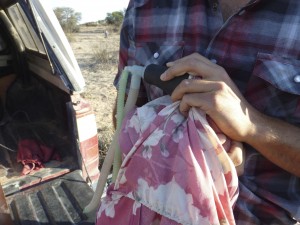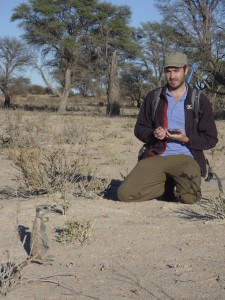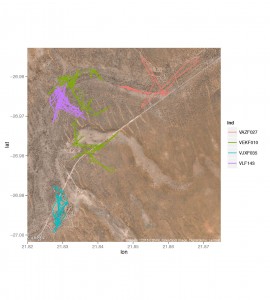After 5 weeks spent in South Africa it is time to draw the first conclusions regarding our new-born project on dispersal in meerkats. I do not want to sound presumptuous but I feel confident saying that this trip has been a great success. And as you know…well begun is half done. But let’s start with some facts from the field.
After few days spent testing the new collars and equipment, getting familiar with the terrain and the road system on the reserve, and getting to know all researchers and volunteers working at the Kalahari Meerkat Project, things got suddenly hectic when one morning we received a radio call from Teja (one of the volunteers) saying that she sighted a female evicted by her natal group a few weeks before being chased by some members of the neighboring group. We could not miss that chance, our first evicted female!

In few minutes and with the much-appreciated help of Lewis and Sky (the project field managers) we prepared the equipment to capture and anesthetize what turned out to be VLF143 (or spelled out: Female 143 of the Lazuli group). It took only a split second for Sky to close his fingers around the base of the tail of VLF143 that, without even noticing, found herself rowing with the four legs in the air before being gently put in a pillow case to be immobilized. Sky and Lewis applied a breathing mask with a mixture of Isoflurane and Oxygen over her head and in few seconds VLF143 was fast asleep. Few minutes later she was up and running again and, as if nothing happened, she resumed her activities. But this time with a collar around her neck. In the following 13 days, thanks to the precious calls of the volunteers – our eyes on the reserve – we successfully collared additional 3 females (VEKF010, VJXF035 and VAZF027) from 3 different groups. Hopefully, by the end of this first field season, we will have collared a total of 10 females.
We are closely monitoring each collared individual to make sure that the collars do not negatively influence the animals and to collect important behavioral and ecological data. Daily observations already allowed collecting important information that will allow fine-tuning our research questions. GPS movement data automatically recorded by the collars at one-hour interval during daytime will be analyzed as a function of environmental factors (e.g. rainfall, temperature), social circumstances (e.g. number of individuals in the dispersing coalition but also their location in relation to unrelated territorial groups) and the animal’s individual state (e.g. body condition, stress level). In the long run, we aim to use information on dispersing individuals such as survival rate and reproductive success to improve already existing population dynamic models.

The first days of our monitoring already provided us with some very useful information. Female VJXF035 lost her sister (VJXF039) with whom she was travelling with after a car run her over. VJXF035 is now back with her group after the dominant female allowed her to rejoin. The collar that we fitted on female VAZF027 (who was dispersing alone) got found lying on the ground…without VAZF027. The collar was covered in blood and fur indicating that VAZF027 got predated, most likely by a raptor. Female VLF143 seems to have found a clever strategy to avoid spending too much time alone (the more eyes scanning around the lower the chance to be taken by a raptor of course); she has already associated, and mated, with 8 different males… I spare you the details. We hope that sooner or later she will build a somehow more stable bond with one or more males and that they will soon set off to find their own territory. Female VEKF010 seems to be the more enterprising and has already crossed the territory of two foreign groups. She has occasionally associated with a couple of males but she seems to be prioritizing a disperser’s business (the actually dispersing) to a disperser’s pleasure (I believe it is clear what I am referring to…).

While I had to return to the foggy and miserable Zurich weather, Nino will remain in the sunny Kalahari until the end of March and will continue monitoring dispersing individuals. More info will follow soon.

Wow ! Well done Gabriele / Nino (& crew). Your time here in SA already well spent & showing results !
Keep it up. Pat & Jenny
Pat, Jenny,
thanks for following us on the blog, hopefully we will have many more interesting posts in the future. And again thanks for your help to get us started, you made our Jo’burg time so much more easy and enjoyable!!!
Hey Gabri and Nino – excellent job! Delighted to read these news (and see the first tracks) 🙂
Hello my name is Mike,I’m 48 yrs old and I live In the United States . I Love the TV SHOW “MEERKAT MANOR” !!! I just HATED it so much when they quit makin the show for Animal Planet, Now all I get to do is watch Re-runs ! As I am doin now . LOL . I have been try to find information on the net about them to see maybe if anyone was still keepin an eye on those little folks or not ? If some of You are still keepin track of them an postin about them could Someone tell Me were I might find that information ? If there is any newer video an stuff on them that You all or anyone else might post on a regular basis that would be Cool also !!! Well anyway if You all are still there watchin them take care and be careful !!! Keep up the GOOD work !!! Oh Yea MERRY CHRISTMAS !
Thank You Much,
Michael Brewer
Hi Michael,
Yes, actually there is always a group of researchers continuing the fieldwork in Kalahari. You can get updates from this website: http://www.kalahari-meerkats.com/
Also, for information on how to get more involved make sure to check out the “Friends” link: http://friends.kalahari-meerkats.com/
The filming continues under different projects. Here is a relatively recent BBC documentary: http://friends.kalahari-meerkats.com/index.php?id=planet_earth_live
All the best and merry Christmas!
Arpat